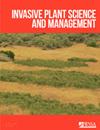Evaluation of novel triclopyr formulations for control of Old World climbing fern (Lygodium microphyllum)
IF 1.2
4区 生物学
Q3 PLANT SCIENCES
引用次数: 1
Abstract
Abstract Old World climbing fern [Lygodium microphyllum (Cav.) R. Br] is a smothering vine that has invaded thousands of hectares of wetlands in southern and central Florida, including the Everglades. For more than two decades, the standard management approach in natural areas has been to cut the vines at waist height, leaving climbing rachis to desiccate in the tree canopy (poodle cutting) and subsequently treat all rooted ground cover with a foliar application of a 3% v/v solution of glyphosate. While this is generally effective, there is increasing interest in providing additional control options and more selective treatments. Along with glyphosate, triclopyr is widely used in invasive plant management and may also provide increased selectivity when treating the ground cover. However, it has not been well tested on L. microphyllum, especially the more recently developed acid and choline formulations. In a series of field trials, we compared the acid, amine, and choline formulations of triclopyr against glyphosate as a positive reference and nontreated plots as a negative reference based on control of L. microphyllum at three wetland sites in southern Florida over the period of 2016 to 2020. Significant reductions in L. microphyllum cover were measured at 1 mo after treatment (MAT) and continued to the termination of the studies at 12 and 28 MAT. We found all three triclopyr formulations applied with a single-nozzle backpack sprayer at 5.4 g ae L–1 provided comparable activity to glyphosate applied at 14.4 g ae L–1. There were few differences in L. microphyllum efficacy among the three triclopyr formulations at each site. These results indicate that triclopyr is a suitable alternative to glyphosate for L. microphyllum control in wetland ecosystems. Future research should evaluate triclopyr efficacy on L. microphyllum in varied hydrologic conditions to better refine treatment prescriptions for wetlands.新型三氯吡啶防治东半球攀缘蕨类植物的评价
东半球攀援蕨类[小叶Lygodium microphyllum (Cav.)]是一种令人窒息的藤蔓植物,它已经入侵了佛罗里达州南部和中部数千公顷的湿地,包括大沼泽地。二十多年来,自然区域的标准管理方法一直是在腰部高度切割葡萄藤,让攀爬的轴在树冠中干燥(卷毛式切割),随后在叶面施用3% v/v的草甘膦溶液处理所有根状地被物。虽然这通常是有效的,但人们对提供额外的控制选择和更多的选择性治疗越来越感兴趣。三氯吡虫啉与草甘膦一起广泛用于入侵植物管理,并且在处理地被物时也可能提供更高的选择性。然而,它还没有很好地测试小叶乳杆菌,特别是最近开发的酸和胆碱制剂。在一系列的田间试验中,我们比较了三氯吡虫啉对草甘膦的酸、胺和胆碱配方作为阳性参比,而未处理的地块作为阴性参比,以2016年至2020年佛罗里达州南部三个湿地的小叶假乳杆菌为对照。在治疗后1个月(MAT)测量了小叶乳杆菌覆盖的显著减少,并持续到研究结束时的12和28 MAT。我们发现,使用单喷嘴背包喷雾器使用的所有三种三氯吡虫啉制剂,在5.4 g / L-1的剂量下,与使用14.4 g / L-1的草甘膦具有相当的活性。3种三氯吡嗪制剂在各部位对小叶乳杆菌的抑菌效果差异不大。上述结果表明,三氯吡虫啉是湿地生态系统中较适合替代草甘膦防治小叶假乳杆菌的药剂。今后的研究应进一步评价三氯吡嗪在不同水文条件下对小叶乳杆菌的治疗效果,以更好地完善湿地的治疗处方。
本文章由计算机程序翻译,如有差异,请以英文原文为准。
求助全文
约1分钟内获得全文
求助全文
来源期刊

Invasive Plant Science and Management
PLANT SCIENCES-
CiteScore
2.20
自引率
9.10%
发文量
24
审稿时长
6-12 weeks
期刊介绍:
Invasive Plant Science and Management (IPSM) is an online peer-reviewed journal focusing on fundamental and applied research on invasive plant biology, ecology, management, and restoration of invaded non-crop areas, and on other aspects relevant to invasive species, including educational activities and policy issues. Topics include the biology and ecology of invasive plants in rangeland, prairie, pasture, wildland, forestry, riparian, wetland, aquatic, recreational, rights-of-ways, and other non-crop (parks, preserves, natural areas) settings; genetics of invasive plants; social, ecological, and economic impacts of invasive plants and their management; design, efficacy, and integration of control tools; land restoration and rehabilitation; effects of management on soil, air, water, and wildlife; education, extension, and outreach methods and resources; technology and product reports; mapping and remote sensing, inventory and monitoring; technology transfer tools; case study reports; and regulatory issues.
 求助内容:
求助内容: 应助结果提醒方式:
应助结果提醒方式:


